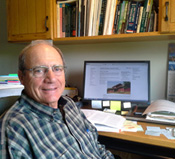Doug Landblom
- Increasing Sustainability of Livestock Production of the Northern Great Plains
- Consequence of perennial and annual forage grazing systems before feedlot entry on yearling steer grazing and feedlot performance, carcass measurements, meat evaluation, and system net return
- The combined effect of beef cattle frame score and forage grazing sequence on yearling steer grazing and feedlot performance, carcass trait measurements, and systems economic
- Effect of heifer frame score on growth, fertility, and economics

 DOUG LANDBLOM - ANIMAL SCIENTIST
DOUG LANDBLOM - ANIMAL SCIENTIST
Doug Landblom is the Dickinson Research Extension Center’s Beef Cattle Specialist. His primary research focus is in beef cattle systems. Landblom has always sought practical methods to reduce input cost without sacrificing animal performance. Most recently, his research has focused on methodologies to integrate crop and beef cattle systems to identify the complementing holistic potential that may exist using alternative grazing-based production approaches. For example, his research has shown that it is more cost effective to wean calves early (August/September) and background them grazing unharvested corn. The procedure results in better gain when grazing corn, the calves experience less respiratory illness, and terminating lactation allows cows to improve body condition prior to the harsh winters of North Dakota. His research has also shown that retaining calves after weaning for yearling summer grazing and finishing can be very profitable. After weaning in November, calves are grown through the winter for modest gain of 1.0 pound/day and then rotated through perennial (crested wheatgrass and native pasture) and annual (field pea/barley and unharvested corn) forages for 182 days before a final feedlot finishing. Calves enter the feedlot weighing approximately 1,200 pounds, which effectively reduces the number of days to slaughter in the feedlot to as few as 75 days or less. Considering all farming and grazing expenses, the extended grazing procedure increases beef value and is profitable without the use of risk management procedures. Small and large frame heifers have been developed using a forage-based dietary regimen. Small frame heifers consume 20% less feed, have similar reproductive performance, and the total development cost for small frame heifers was lower suggesting that high breeding efficiency can be attained with smaller framed heifers.
Questions and comments can be directed to Mr. Landblom by clicking on his e-mail link.
________________________________
Contact Information
Doug Landblom
1089 State Avenue
Dickinson, ND 58601
FAX: (701) 456-1109
(701) 483-2072
douglas.landblom@ndsu.edu

